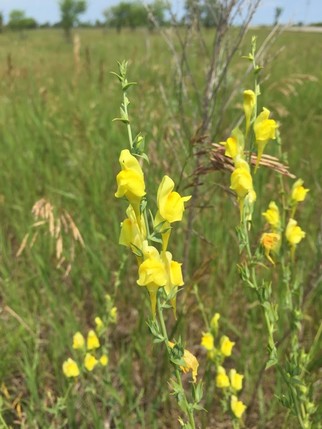|
August 30, 2019
September Weed of the Month: Dalmatian Toadflax
Emilie Justen, Minnesota Department of Agriculture

A perennial plant native to the Mediterranean is September’s Weed of the Month. Dalmatian toadflax (Linaria dalmatica) was brought to the western United States as an ornamental, escaped cultivation, and has become a noxious weed throughout many western states. Dalmatian toadflax invades and overtakes grasslands, rangelands, pastures, natural areas, and disturbed areas. These infestations have reduced livestock production, land values, biodiversity, and wildlife habitat.
Dalmatian toadflax is a short-lived perennial with waxy, bluish-green stems and leaves. The weed has yellow flowers, sometimes with orange centers, arranged on spikes that look similar to a snapdragon. The plant can grow to four feet. It prefers sunny areas with well-drained, coarse-textured soils. Dalmatian toadflax spreads by seed and by lateral roots.
|
Yellow toadflax, also called butter-and-eggs (Linaria vulgaris), is a Dalmatian toadflax look-alike and is commonly found in Minnesota, but has small, narrow, linear leaves compared to Dalmatian toadflax’s thick, waxy, heart-shaped leaves. Yellow toadflax is also considered to be a weedy species, but is far less aggressive and damaging than Dalmatian toadflax and is not regulated under the Noxious Weed Law.
In Minnesota, Dalmatian toadflax is established in Kittson and Cook counties. Ongoing efforts in both counties to eradicate Dalmatian toadflax brought together United States Forest Service, the Nature Conservancy, private landowners and the Minnesota Departments of Agriculture, Natural Resources and Transportation along with staff from both counties.
Dalmatian toadflax’s thick, waxy leaves resist the penetration of many herbicide formulations, making it a challenging noxious weed to treat. Mowing is not recommended because equipment can spread seed and root fragments. Hand pulling individual plants can be effective in light or moist soils that allow removal of the entire root, but gloves should be worn for all hand pulling. For herbicide recommendations, please contact University of Minnesota Extension or your local County Agriculture Inspector.
To report infestations of Dalmatian toadflax or any other noxious weeds on the eradicate list, please notify the Minnesota Department of Agriculture at arrest.the.pest@state.mn.us or 1-888-545-6684.
PHOTO
Caption:Dalmatian toadflax has yellow flowers with a distinctive spur at the base of the flower. (Click here to download.)
MEDIA: For more information on Weed of the Month, contact Allen Sommerfeld, MDA Communications, at allen.sommerfeld@state.mn.us or 651-201-6185
Having trouble viewing this email? View it as a Web page.
|